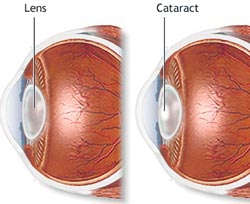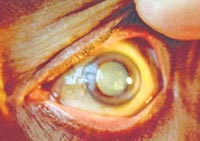
If your world gets blurred...Cataracts are a common eye disorder, occurring mainly in the elderly. They are the most common cause of reversible blindness, says Dr. H. Palihakkara, Consultant Ophthalmologist, and can be cured permanently with surgery. Although cataract surgery is a safe and effective procedure, unfortunately many suffer needlessly due to unfounded fears and misconceptions regarding it, he says, explaining the various causes, symptoms and treatments available for cataracts, in this interview with MediScene. What is a cataract? A cataract is a clouding of the normally clear lens of the eye. When the lens becomes opaque, it is called a cataract. The lens works much like a camera lens, focusing light onto the retina at the back of the eye. It also adjusts the eye's focus, letting us see things clearly both up close and far away. Certain proteins in the lens may alter with age, clouding an area of the lens. This is a cataract, and over time, it may grow larger and cloud more of the lens, making it harder to see. This is usually a gradual process, even taking up to several years.
Cataracts are classified as one of three types: A nuclear cataract forms in the centre of the lens. Symptoms The main symptom of cataracts is poor, blurry vision that cannot be corrected with glasses. Furthermore, light from the sun, lamps or oncoming headlights may seem too bright. Cataracts don't typically cause any change in the appearance of the eye. The ring that sometimes appears around the iris of the eye is not a sign of a cataract, nor is pain, redness, itching, irritation, aching or discharge from the eye. These may be signs and symptoms of other eye disorders. Causes Cataracts mainly occur with aging. However, cataracts can occur at any age due to a variety of reasons. Congenital cataracts, or those that are present at birth, may develop due to some infection during pregnancy, particularly rubella or German measles. Several other factors such as diabetes, certain metabolic diseases, eye disorders such as glaucoma, and even mild trauma to the eye, can cause cataracts. Those with a family history of cataracts are also more prone to the disorder. Exposure to ultraviolet light is associated with cataract development, so wearing sunglasses is recommended as a protective measure. Treatment The only effective treatment for a cataract is surgery to remove the clouded lens, which includes replacing the lens with a clear lens implant. The surgery is 100% effective, and the cure is permanent. The latest technology used in cataract surgery involves removal of the part of the lens affected by the cataract using ultrasound. An artificial lens is then inserted into the eye, thereby preserving the complete anatomical structure of the patient's eye.
Local anaesthesia is used, stitches are not necessary and no hospital stay is required, with patients being able to return home soon after surgery. Typically there is complete visual recovery within a week. Short-sightedness is also naturally corrected during the surgery, and these patients usually do not need to use glasses afterwards. Patients are advised to stay at home for a week after the surgery to minimise exposure to dust and germs. They should clean their eyes with boiled, cooled water and sterile cotton wool at least thrice a day as well as administer eye drops as prescribed by the doctor, to avoid infection. Multi-focal lenses, which can correct both short and far-sightedness are still in the developmental stage, but with time can be expected to improve the quality of vision provided after cataract surgery. |
|| Front
Page | News | Editorial | Columns | Sports | Plus | Financial
Times | International | Mirror | TV
Times | Funday
Times | Medi Scene || |
| |
Copyright
2007 Wijeya
Newspapers Ltd.Colombo. Sri Lanka. |

